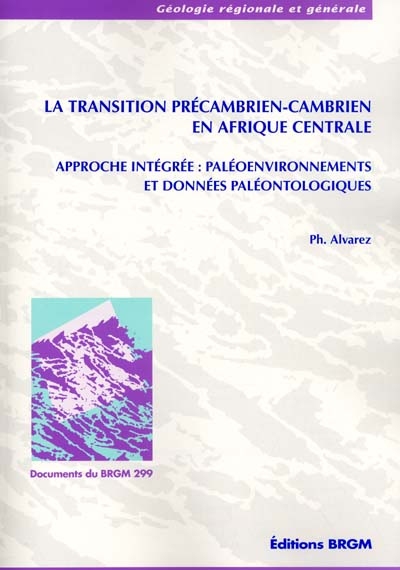Frais de port offerts dès 30 € d’achat (France Métropolitaine)

Frais de port offerts dès 30 € d’achat (France Métropolitaine)
 Panier
0
Panier
0
 Panier
0
Panier
0
 Mon panier (0 )
Mon panier (0 )
Votre panier est vide
























En Afrique centrale, l'étude de la période de transition Précambrien-Cambrien est abordée selon une démarche intégrant la sédimentation, les paléoenvironnements, la stratigraphie séquentielle et génétique, et la paléontologie. Un calage chronologique nouveau est proposé. Dans les dépôts détritiques, la méthode quantitative de distribution des éléments discriminants permet de définir une chronologie relative basée sur l'évolution paléoclimatique des zones sources à l'origine du flux particulaire et des environnements sédimentaires d'un système fluvio-deltaïque à exutoire palustro-lacustre. Postérieure à une période glaciaire majeure, l'installation, dans l'avant-pays des chaînes panafricaines, d'une sédimentation carbonatée généralisée traduit un net réchauffement climatique en relation avec une phase transgressive d'origine clairement glacio-eustatique (cycle de 2ème ordre). La phase régressive tectono-eustatique s'organise selon un profil hydrodynamique de rampes avec barrière oolitique où les faciès lagunaires à proliférations microalgaires et les dépôts de plage, adossés à de vastes glacis continentaux, sont bien exprimés (rampe schisto-calcaire du Congo, Gabon et Bas-Zaïre ; rampe Nord-Afrique centrale du Centrafrique et Nord de la RDC dont les rythmites infratidales de la région de Bangui permettent d'établir un cycle lunaire à 29-30 jours utilisable comme repère cyclo-stratigraphique d'ordre cosmologique plus récent que 650 Ma). Enfin, au Congo, Bas-Zaïre et Angola, la découverte, pour la première fois au Gondwana, dans la Formation de l'Oolithe de Kisantu d'une association à trois morphoespèces, exceptionnellement épigénisées en talc diagénétique, du genre Obruchevella (cyanobactérie) dont O. kisantuensis nov. sp. n'exclut pas un âge cambrien basal pour la mise en place des rampes carbonatées d'Afrique centrale.
A study of the Cambrian-Precambrian transition in Central Africa, integrating sedimentation, paleoenvironments, sequence and genetic stratigraphy, and paleontology, has led to a new chronological calibration. Using the quantitative method of discriminant element distribution in the detrital deposits makes it possible to define a relative chronology based on the paleoclimatic evolution of i) source zones of particle flux, and ii) sedimentary environments of a fluvio-deltaic system with a palustro-lacustrine outlet. A major period of glaciation was followed by widespread carbonate sedimentation in the foreland of the Panafrican ranges, reflecting a net climatic warming associated with a transgressive phase that was clearly of glacio-eustatic origin (2nd order cycle). The tectono-eustatic regressive phase gave rise to a hydrodynamic profile of ramps with oolitic barriers and well-developed lagoonal facies with microalgal proliferations and beach deposits backing onto vast continental glacis -i.e. the schist-limestone ramp of the Congo, Gabon and Bas-Congo (Democratic Republic of the Congo - DRC), and the central North-African ramp of the Central African Republic and northern-DRC and where infratidal rhythmites in the Bangui region have made it possible to establish a 29-30-day lunar cycle that can be used as a cosmological cyclo-stratigraphic indicator younger than 650 Ma. Finally, for the first time in Gondwana, the discovery in the Kisantu Oolite Formation of the Congo, Bas-Zaïre (DRC) and Angola of an association with three morphospecies of the genus Obruchevella (cyanobacteria), exceptionally epigenized to diagenetic talc and including O. kisantuensis nov. sp., does not exclude a basal Cambrian age for the formation of the carbonate ramps in Central Africa.
Auteur : Alvarez, Philippe
Date de parution : 15/04/2001
Éditeur : BRGM
Collection : Documents, Géologie régionale et générale
Classification : Sciences de la vie et de la terre

(France Métropolitaine)
07400 Le Teil (Ardèche)
Carte bancaire
06 70 63 29 00
check_circle
check_circle